NCERT Solutions For Class 8 Science Chapter 10 - Light: Mirrors and Lenses
Think simply of being in front of a mirror and seeing your reflection alter as you move your position closer or further away- that is the simplest indication of how light can behave when it is covered by mirrors and lenses in our daily lives. The chapter titled Class 8 Science Chapter 10: Light - Mirrors and Lenses discusses these interesting phenomena, and they include the laws of reflection, the formation of images using a curved mirror, the refraction of light using lenses and how they are applied in real life. It is a very important chapter because it provides a basis for higher levels of optics in Class 10 and competitive examinations such as CBSE Boards, JEE and NEET.
This Story also Contains
- NCERT Solution for Class 8 Science Chapter 10 Download PDF
- Light: Mirrors and Lenses NCERT Solutions: Exercise Questions
- Light: Mirrors and Lenses Class 8 Science Chapter 10: Additional Questions
- Light: Mirrors and Lenses Class 8 Science Chapter 10: Topics
- Approach to Solve Questions of Class 8 Science Chapter 10 – Light: Mirrors and Lenses
- Benefits of NCERT Solutions for Class 8 Science Curiosity Chapter 10
- NCERT Solutions for Class 8 Science Chapter Wise
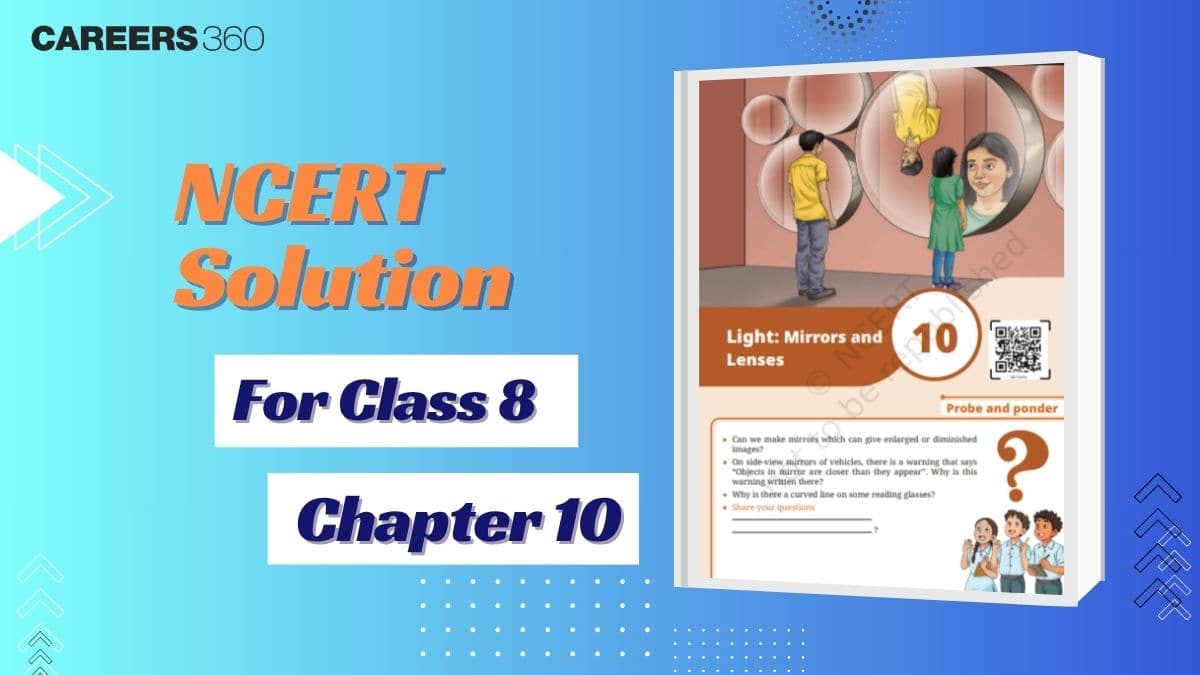
The NCERT Solutions for Class 8 Science Chapter 10 - Light: Mirrors and Lenses provide step-wise solutions to all the exercises in the textbook, such as MCQs, short answers and long answers. The following NCERT solutions assist students to have a clear conception about different concepts like regular reflection, diffused reflection, the type of mirrors and lenses, focal length and daily applications of optical devices such as spectacles, microscopes and telescopes. These NCERT Solutions for Class 8 Science Chapter 10 - Light: Mirrors and Lenses are structured according to the current NCERT syllabus (2025-26) and, besides being helpful in preparation for examination, can also help a student become more analytical and problem-solvable. Being well organised, with explanations, diagrams and examples of answers, the Light: Mirrors and Lenses NCERT Solutions PDF Class 8 serves as a very powerful revision tool as students are able to study anytime and even without an online connection. Through these class 8 science Light: Mirrors and Lenses question answers, learners will be able to reinforce their fundamentals of light, reduce errors and have the confidence to perform well at school and also at competitive exams.
NCERT Solution for Class 8 Science Chapter 10 Download PDF
Light: Mirrors and Lenses Class 8 question answers are properly structured to provide answers to all the questions in the textbook, and this is why this resource simplifies the gathering of various concepts necessary for students the most. The PDF format can be downloaded so that it can be studied and revised wherever, at any time.
Light: Mirrors and Lenses NCERT Solutions: Exercise Questions
Class 8 Science Chapter 10 - Light: Mirrors and Lenses question answers are the clear answers to all the questions in the exercise of the textbook. Laws of reflection, mirror and lens types, image formation, and their practical uses are some of the major concepts that are explained in these solutions. Planned according to the newest NCERT syllabus (2025-26), class 8 science chapter 10 Light: Mirrors and Lenses question answers will assist the students to reinforce the knowledge, revise successfully and pass examinations calmly.
Q1: A light ray is incident on a mirror and gets reflected by it (Fig. 10.21). The angle made by the incident ray with the normal to the mirror is 40°. What is the angle made by the reflected ray with the mirror?
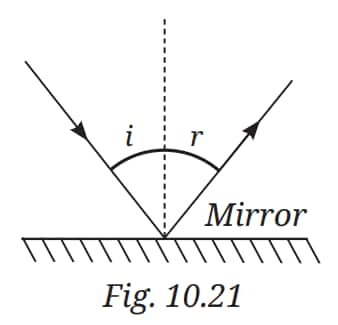
(i) 40°
(ii) 50°
(iii) 45°
(iv) 60°
Answer:
The angle made by the incident ray with the normal (angle of incidence) is 40°.
By the law of reflection, ∠i = ∠r, so, angle of reflection is also 40°.
The angle made by the reflected ray with the mirror is 90∘−40∘=50∘
So, the correct answer is (ii) 50°.
Q2: Fig. 10.22 shows three different situations where a light ray falls on a mirror:
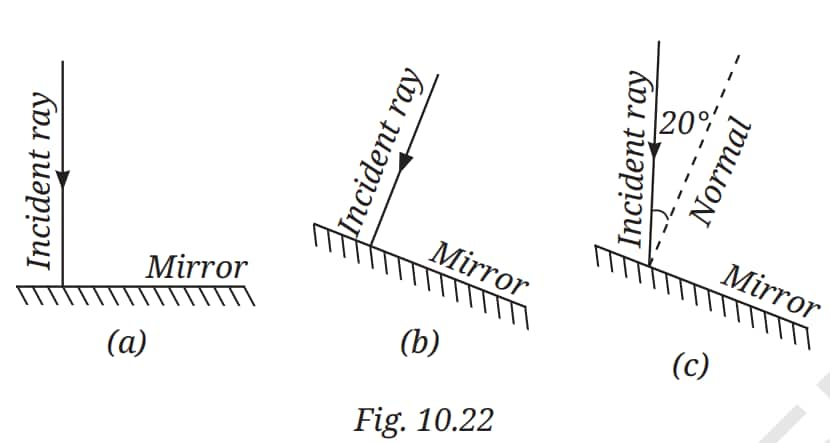
(a) The light ray falls along the normal.
(b) The mirror is tilted, but the light ray still falls along the normal to the tilted surface.
(c) The mirror is tilted, and the light ray falls at an angle of 20° from the normal.
Draw the reflected ray in each case (Use a ruler and protractor for accurate drawing). What is the angle of reflection in each case?
Answer:
Case (i):
The light ray falls exactly along the normal (perpendicular to the surface).
The angle of incidence = 0°, so the angle of reflection = 0°.
The reflected ray goes straight back along the same path.
Case (ii):
The mirror is tilted, but the light ray again falls along the normal to the tilted surface.
The angle of incidence = 0°, so the angle of reflection = 0°.
The reflected ray goes straight back on itself.
Case (iii):
The mirror is tilted, and the light ray falls at a 20° angle from the normal.
Angle of incidence = 20°, so angle of reflection = 20°.
Draw the reflected ray on the other side of the normal, at 20°.
Q3: In Fig. 10.23, the cap of a sketch pen is placed in front of three types of mirrors.
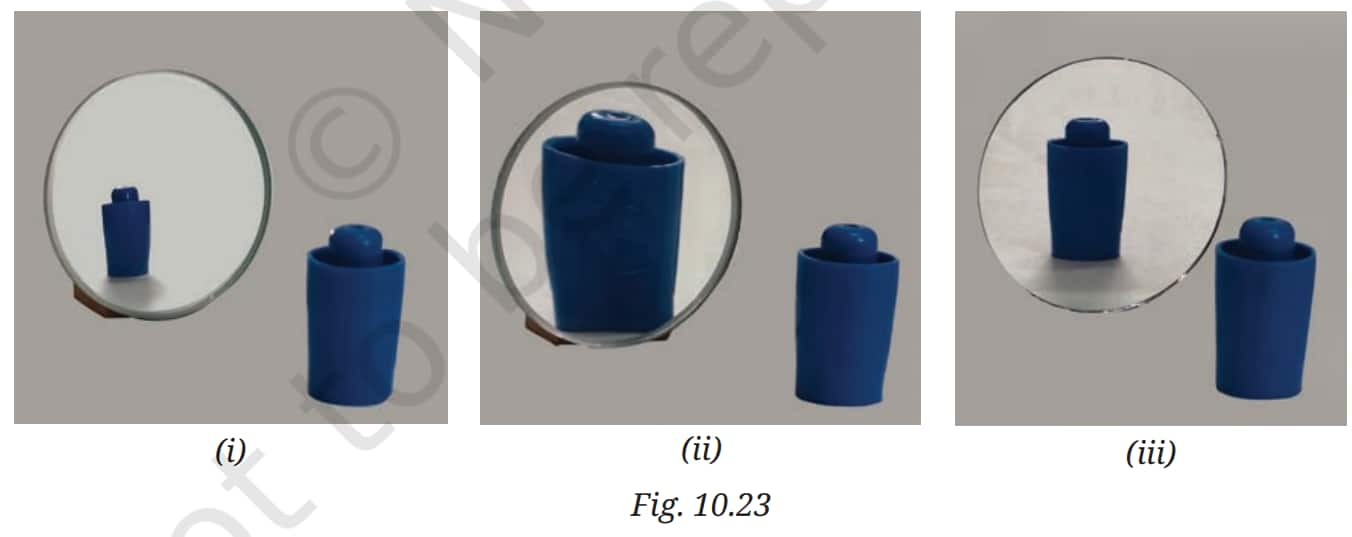
Match each image with the correct mirror.
Image | Mirror |
(i) | Plane mirror |
(ii) | Convex mirror |
(iii) | Concave mirror |
Answer:
Image (i): Smaller, erect, and covers a wide area → Convex mirror.
Image (ii): Enlarged, depending on distance → Concave mirror.
Image (iii): Same size, erect → Plane mirror.
Q4: In Fig. 10.24 the cap of a sketch pen is placed behind a convex lens, a concave lens, and a flat transparent glass piece — all at the same distance. Match each image with the correct type of lens or glass.
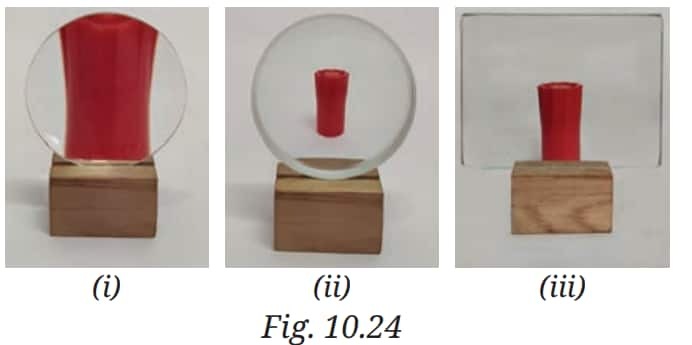
Image | Lens/Glass type |
(i) | Flat transparent glass piece |
(ii) | Convex lens |
(iii) | Concave lens |
Answer:
Image (i): Larger than object (enlarged) → Convex lens.
Image (ii): Smaller than object (diminished) → Concave lens.
Image (iii): Same size as object → Flat transparent glass piece.
Q5: When the light is incident along the normal on the mirror, which of the following statements is true:
(i) Angle of incidence is 90°
(ii) Angle of incidence is 0°
(iii) Angle of reflection is 90°
(iv) No reflection of light takes place in this case
Answer:
(ii) Angle of incidence is 0°.
(The incident ray is perpendicular to the mirror, so the angle is zero.)
Q6: Three mirrors—plane, concave and convex are placed in Fig. 10.25. On the basis of the images of the graph sheet formed in the mirrors, identify the mirrors and write their names above the mirrors.

Answer:
The mirror showing the same size grids: Plane mirror
The mirror showing a smaller, wider grid: Convex mirror
The mirror showing larger or possibly distorted grids, especially near the centre: Concave mirror
So, from left to right:
Convex mirror
Plane mirror
Concave mirror
Q7: In a museum, a woman walks towards a large convex mirror (Fig. 10.26). She will see that:

(i) Her erect image keeps decreasing in size.
(ii) Her inverted image keeps decreasing in size.
(iii) Her inverted image keeps increasing in size and eventually it becomes erect and magnified.
(iv) Her erect image keeps increasing in size.
Answer:
(i) Her erect image keeps decreasing in size.
Convex mirrors always show a small, erect image, and as you go closer, the image gets even smaller.
Q8: Hold a magnifying glass over the text and identify the distance at which you can see the text bigger than they are written. Now move it away from the text. What do you notice? Which type of lens is a magnifying glass?
Answer:
As you bring the magnifying glass (convex lens) close to the text, you see the letters appear bigger (enlarged and erect) at a certain distance.
If you move the lens too far, the image can become inverted or blurry.
A magnifying glass uses a convex lens.
Q9: Match the entries in Column I with those in Column II.
Column I | Column II |
(i) Concave mirror | (a) Spherical mirror with a reflecting surface that curves inwards. |
(ii) Convex mirror | (b) It forms an image which is always erect and diminished in size. |
(iii) Convex lens | (c) An object placed behind it may appear inverted at some distance. |
(iv) Concave lens | (d) An object placed behind it always appears diminished in size. |
Answer:
Column I | Column II |
(i) Concave mirror | (a) Spherical mirror with a reflecting surface that curves inwards. |
(ii) Convex mirror | (b) It forms an image which is always erect and diminished in size. |
(iii) Convex lens | (c) An object placed behind it may appear inverted at some distance. |
(iv) Concave lens | (d) An object placed behind it always appears diminished in size. |
Q10: The following question is based on Assertion/Reason.
Assertion: Convex mirrors are preferred for observing the traffic behind us.
Reason: Convex mirrors provide a significantly larger view area than plane mirrors. Choose the correct option:
(i) Both Assertion and Reason are correct, and Reason is the correct explanation for Assertion.
(ii) Both Assertion and Reason are correct, but Reason is not the correct explanation for Assertion.
(iii) Assertion is correc,t but Reason is incorrect.
(iv) Both Assertion and Reason are incorrect.
Answer:
Convex mirrors show a wider field of view, so they are used as rear-view mirrors.
So, the correct answer is option (i) Both Assertion and Reason are correct and Reason is the correct explanation for Assertion.
Q11. In Fig. 10.27, note that O stands for object, M for mirror, and I for image. Which of the following statements is true?
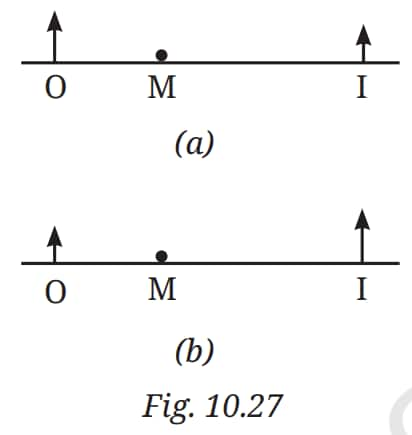
(i) Figure (a) indicates a plane mirror and Figure (b) indicates a concave mirror.
(ii) Figure (a) indicates a convex mirror and Figure (b) indicates a concave mirror.
(iii) Figure (a) indicates a concave mirror and Figure (b) indicates a convex mirror.
(iv) Figure (a) indicates a plane mirror and Figure (b) indicates a convex mirror.
Answer:
(ii) Figure (a) indicates a convex mirror and Figure (b) indicates a concave mirror.
In a convex mirror, the image formed is always erect and diminished. In a concave mirror, the erect and enlarged image is formed behind the mirror
Q12. Place a pencil behind a transparent glass tumbler (Fig. 10.28a). Now fill the tumbler halfway with water (Fig. 10.28b). How does the pencil appear when viewed through the water? Explain why its shape appears changed.
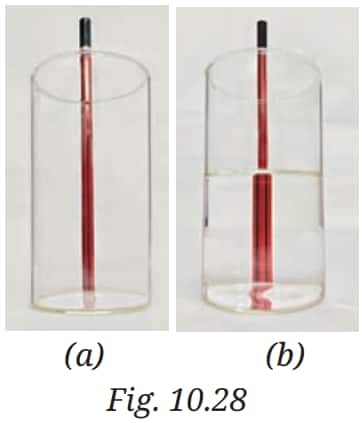
Answer:
The pencil appears bent or broken at the water surface—this is called refraction.
Reason: The light rays change direction as they pass from water to air (because water and air have different densities), so the pencil seems displaced or bent at the surface.
Light: Mirrors and Lenses Class 8 Science Chapter 10: Additional Questions
Class 8 science chapter 10- Light: Mirrors and Lenses assists the student to learn about how light acts when it falls on shiny surfaces or goes through lenses. In this chapter, the fundamental understanding of the topic of reflection, refraction and image formation is established. The additional questions help the students to use these concepts in real-life cases such as mirrors, spectacles, and cameras, which enhances the clarity of the concepts and the exam preparation.
Q1: How is the phenomenon of reflection used in making a kaleidoscope? What are the applications of a kaleidoscope?
Answer:
A kaleidoscope consists of a cylinder with three mirrors filled with loose, colored materials like glass fragments and beads or stones. As the observer stares into one end, light reflected from the other end forms a vibrant pattern. The multiple reflection principle is used, in which a number of mirrors are positioned at an angle to each other, typically
The following are some of its uses:
i. It is used in toys, decorations, and other things.
ii. Designers and artists also use kaleidoscopes to generate unique designs for fabrics, jewellery, and wallpaper.
Q2: Boojho planned an activity to observe an object A through pipes as shown in Fig. 16.8, so that he could see objects which he could not directly see.
(a) How many mirrors should he use to see the object?
(b) Indicate the positions of the mirrors in the figure.
(c) What must be the angle with respect to the incident light at which he should place the mirrors?
(d) Indicate the direction of rays in the figure.
(e) If any of the mirrors is removed, will he be able to see the objects?
Answer:
(a) He should use three mirrors to see the object.
(b)

(c) The angle with respect to the incident light at which he should place the mirrors must be 45o.
(d)
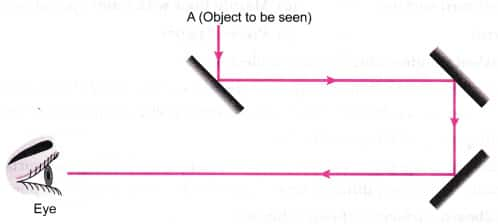
(e) No, he will not be able to see the objects.
Q3: The distance between the object and its image formed by a plane mirror appears to be 24 cm. What is the distance between the mirror and the object?
Answer:
The distance between the object and the image is the sum of the distances between the image & mirror, and the object & mirror. When a plane mirror is used, the distance between the mirror and the object is the same as the distance between the mirror and the image. Assume that the image and the mirror are separated by x.
Then, the distance from the object to the mirror is also x.
So,
Therefore, there is a 12 cm distance between the object and the mirror.
Light: Mirrors and Lenses Class 8 Science Chapter 10: Topics
Chapter 10, Light: Mirrors and Lenses, of Class 8 Science opens a new world to the kids about optics. It describes the behaviour of light- its reflection and refraction, formation of image due to different surfaces, and also the uses of mirrors and lenses in our everyday life and in laboratory equipment. This chapter of the NCERT solution for class 8 science provides a solid path to realising and comprehending the physics of vision and optical equipment.
10.1 What Are Spherical Mirrors?
- Spherical mirrors are mirrors that have curved edges, and the reflecting surfaces belong to a sphere. Two types of them exist:
- Concave mirrors (inward-curved reflective surface) -focus light and can be found in things such as shaving mirrors, telescopes, and headlights.
- Convex mirrors (reflective surface extends outwards) -spread the light and are popularly applied as a rear mirror in automobiles.
- Both of them possess a pole (P), centre of curvature (C), principal axis and focus (F), and these contribute towards how they form an image.
10.2 What Are the Characteristics of Images Formed by Spherical Mirrors?
- The images formed depend on the location of the object relative to the focus and centre of curvature of the mirror. In the case of the concave mirrors, it may have either a real or virtual image, which is either magnified, diminished and inverted, or upright. When dealing with convex mirrors, the image will always be virtual, erect and diminished. These characteristics can be understood with the help of a ray diagram in various object positions.
10.3 What Are the Laws of Reflection?
- The reflection of light follows two basic laws:
- Law of incidence and reflection – The angle of incidence equals the angle of reflection.
- Plane of incidence – The incident ray, reflected ray, and normal to the mirror at the point of incidence lie in the same plane.
These laws are valid for both plane and spherical mirrors.
10.4 What Is a Lens?
A lens is a clear optical instrument with one or more curved surfaces, which can converge or diverge light.
- Convex lens (thicker at the middle) -focuses light, and it is capable of forming an image (real) or an image (virtual) depending on the position of the object being used.
- Concave lens (thinner in the centre) -this lens diverges light with the effect that it will produce virtual, erect, and reduced images all the time.
- There are numerous applications of lenses, which include spectacles, microscopes, and cameras, as well as magnifying glasses.
Approach to Solve Questions of Class 8 Science Chapter 10 – Light: Mirrors and Lenses
The chapter Light: Mirrors and Lenses presents to students the behaviour of light as it reflects off mirrors and bends through lenses that are quite interesting. As a way of solving questions in this chapter, students are recommended to concentrate on the conceptual clarity, application of real-life relations, and provision of answers in the form of diagrams where needed. Here's a smart approach:
- Break Down Image Formation: To find the answers to questions of ray diagrams, it is better to use a step-by-step approach:
- Determine the mirror/lens type.
- Place the object correctly.
- Draw at least two rays (parallel or through focus or centre of curvature).
- Locate the image.
- Apply the "Why" Technique: It is always important to ask why an image is bigger, smaller, upright or inverted. Explanations are also enhanced by writing reasoning in answers and increasing marks.
- Think Application-Oriented: Lots of exam questions are connected to everyday applications, such as why dentists use concave mirrors or why magnifying glasses use convex lenses. Pay attention to application-based reasoning.
- Differentiate using tables to make sense: Tables should be used when asked to compare convex mirrors/lenses with concave mirrors/ lenses. This assists in the display of answers in a tidy manner and the achievement of the full marks.
- Use Mnemonics for Properties: Prepare easy memory aids of focal length, curvature radius or image characteristics (such as Size, Inverted/Upright, Real/Virtual) to remember easily when doing exams.
- Connect to Topics of Higher Level: The Majority of these basics are associated with advanced optics in Class 10 and later on. Not only do it to study physics more at higher levels, but also to help in the future.
- Practice Mixed Question Types: It is not only necessary to stick to NCERT in-text questions, but HOTS (Higher Order Thinking Skills), assertion-reasoning and case-based questions to hone analytical ability.
Benefits of NCERT Solutions for Class 8 Science Curiosity Chapter 10
The Light: Mirrors and Lenses Class 8 question answers can help students to find simple step-by-step answers to all the questions in the textbook, and hence, preparing for the exam is not that tough. These class 8 science chapter 10 Light: Mirrors and Lenses question answers enhance conceptual learning on significant issues like laws of reflection, mirror image construction, applications of concave and convex lenses, and applications of light in real life. With the help of these Class 8 NCERT Science Solutions, students can:
- Learn within a short time with clear explanations of terms such as image formation and ray diagrams.
- Enhance the precision of responses using point-by-point solutions.
- Develop a strong background in optics, which is required in the next classes as well as competitive exams such as CBSE Boards, JEE and NEET.
- Practice important NCERT Class 8 Science questions in a systematic way, reducing last-minute exam stress.
These Light: Mirrors and Lenses class 8 question answers are useful learning aids; they assist the students to feel confident and prevent the most frequent mistakes, and achieve higher marks in their school science examinations.
NCERT Solutions for Class 8 Science Chapter Wise
Chapter-wise NCERT Solutions Class 8 Science are very well-organised answers to each of the questions of the latest NCERT book, each one solidifying concepts in the mind of the reader, so that he/she can not only have a good grasp of the topic but also be ready to tackle the exam. These solutions are resourceful as they include every chapter in detail, hence learning is more organised and easier to revise.
Frequently Asked Questions (FAQs)
Knowledge of light enables our capacity to understand how we see, how optical systems work, and how light behaves on surfaces.
It describes how mirrors, lenses, spectacles, cameras, telescopes and rear-view mirrors work, all of which are used in daily life.
Yes, reflection and refraction are usually found in school-level competitive exams and kind of form a foundation for higher concepts in physics.
Ray diagrams and real-life applications help students to develop their observational skills, their thinking process and their ability to arrive at a solution.
The science of photography, optometry, astronomy, and physics is one of the careers that are among those that are so dependent on the science
Class 8 Science Chapter 10, Light: Mirrors and Lenses, is essential in exams as it assists students in comprehending the most prominent concepts of refraction and reflection. It defines the way light acts under the action of various surfaces, such as mirrors and lenses, using simple experiments and diagrams. The chapter lays the foundation for advanced optics topics and contains numerous diagram-based and logical questions that are frequently used in exams.
A common misunderstanding is that diffused reflection violates the laws of reflection. NCERT explains that even on uneven surfaces, the principles of reflection are always followed by every beam; the irregularities merely cause the rays to disperse in different directions.
Courses After 12th
Applications for Admissions are open.
As per latest syllabus. Physics formulas, equations, & laws of class 11 & 12th chapters
JEE Main Important Chemistry formulas
Get nowAs per latest syllabus. Chemistry formulas, equations, & laws of class 11 & 12th chapters
JEE Main high scoring chapters and topics
Get nowAs per latest 2024 syllabus. Study 40% syllabus and score upto 100% marks in JEE
JEE Main Important Mathematics Formulas
Get nowAs per latest syllabus. Maths formulas, equations, & theorems of class 11 & 12th chapters

